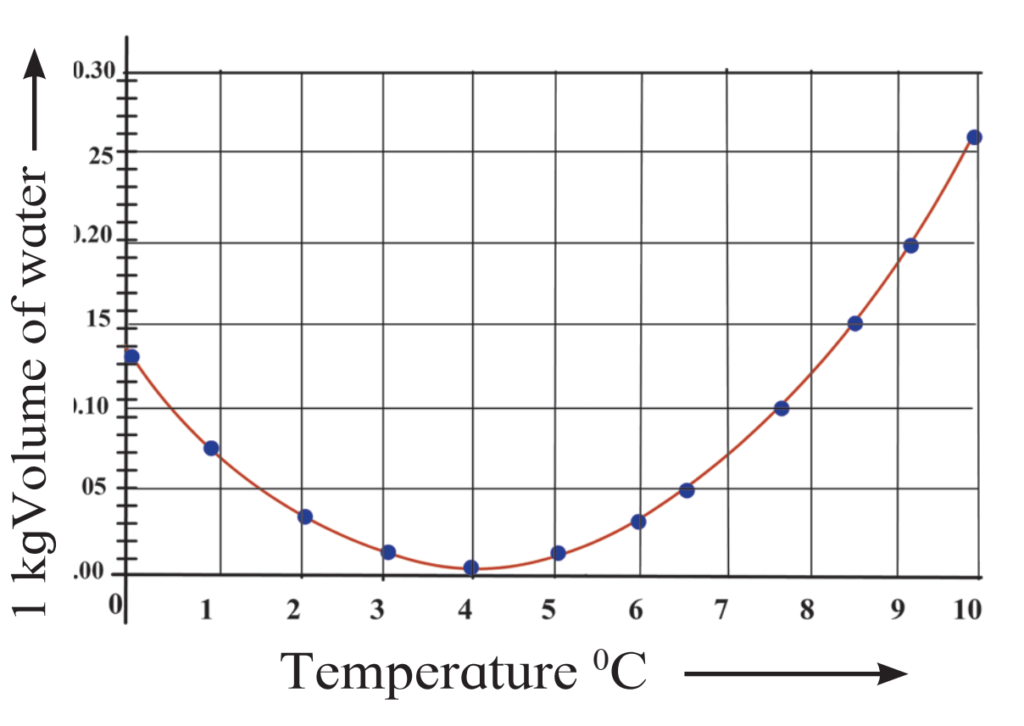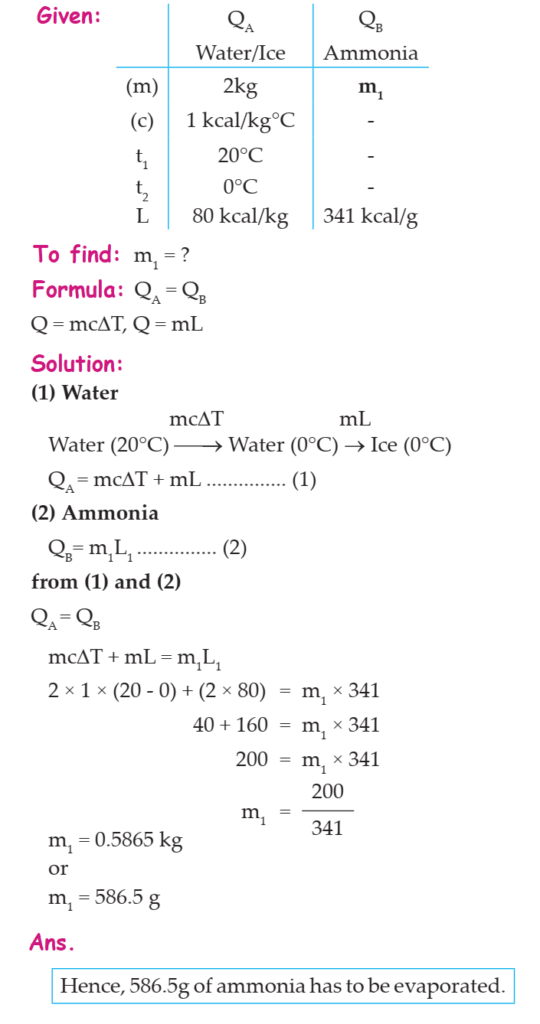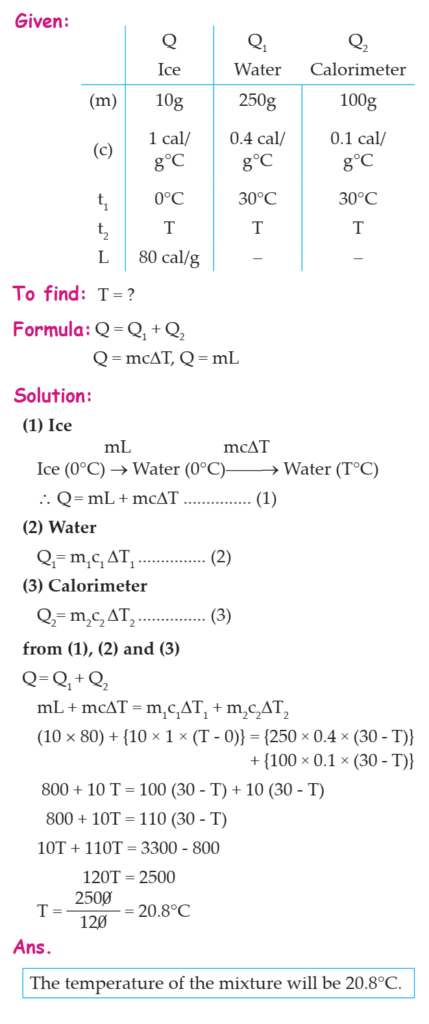1. Fill in the blanks and rewrite the sentence.
(a) The amount of water vapor in air is determined in terms of its …………
(b) If objects of equal masses are given equal heat, their final temperature will be different. This is due to difference in their ………………
(c) During transformation of liquid phase to solid phase, the latent heat is ………….
(a) The amount of water vapor in air is determined in terms of its absolute humidity.
(b) If objects of equal masses are given equal heat, their final temperature will be different. This is due to difference in their specific heat capacities.
(c) During transformation of liquid phase to solid phase, the latent heat is released.
2. Observe the following graph. Considering the change in volume of water as its temperature is raised from 0°C, discuss the difference in the behaviour of water and other substances. What is this behaviour of water called?

If the temperature of water is raised from 0 °C to 10 °C, its volume goes on decreasing in the range 0 °C to 4 °C. It is minimum at 4 °C. The volume of water goes on increasing in the range 4 °C to 10 °C. In general, when a substance is heated, its volume goes on increasing with temperature. Thus, in the range 0 °C to 4 °C, behaviour of water is different from other substances. It is called anomalous behaviour of water.
3. What is meant by specific heat capacity? How will you prove experimentally that different substances have different specific heat capacities?
(i) The amount of heat energy required to raise the temperature of a unit mass of an object by 1 ”C is called the specific heat capacity of that object.

(i) The amount of heat energy required to raise the temperature of a unit mass of an object by 1 ”C is called the specific heat capacity of that object.
(ii) Three solid spheres of equal masses of material iron, copper and lead are placed in boiling water for same time. After removing them simultaneously, they are placed on the wax tray together.
(iii) Initially, all spheres have temperature of 100°C. The sphere which absorbs more heat can melt more wax.
(iv) Iron sphere melts more wax and goes deep into it. The lead sphere goes less deep into the molten wax. The copper sphere goes to intermediate depth.
(v) This indicates that the heat absorbed by different material differs. This is specific heat capacity of metals.
(vi) Specific heat capacity is denoted by letter ‘c’. In CGS, it is measured in cal/g°C, while in MKS, it is measured in J/kg°C
4. While deciding the unit for heat, which temperatures interval is chosen? Why?
The temperature range of 14.5°C to 15.5°C is chosen while deciding the unit for heat because if we heat 1 kg of water by 1°C in different temperature range than 14.5°C to 15.5°C, the amount of heat required will be slightly different.
5. Explain the following temperature vs time graph. (March-July ’19)

The graph shows what happens when a mixture of ice and water is heated continuously. The temperature of the mixture remains constant (0 °C) till all the ice melts as shown by the line AB. This temperature is the melting point of ice. On further heating, the temperature rises steadily from 0 °C to 100 °C as shown by the line BC, at 100 °C water starts converting into steam. This temperature is the boiling point of water. Further heating does not change the temperature and the conversion water → steam continues as shown by the line CD.
(a) What is the role of anomalous behaviour of water in preserving aquatic life in regions of cold climate?
Ans. (i) In cold countries during winter, the temperature of air falls to 0°C or even below.
(ii) As the temperature of air decreases, the water at the surface of the lake begins to contract due to which its density increases.
(iii) When the temperature of the water falls below 4°C then due to its anomalous behaviour, the water expands instead of contracting.
(iv) As the temperature of water falls to 0°C the water on the surface of the lake gets converted to ice.
(v) Since ice is a bad conductor of heat the water below the ice layer continues to remain at 4°C even through the temperature of air may fall below 0°C.
(vi) Hence, due to the anomalous behaviour of water, aquatic animals stay alive even when the temperature of air falls below 0°C.
(b) How can you relate the formation of water droplets on the outer surface of a bottle taken out of refrigerator with formation of dew?
Ans.
(i) When the bottle is taken out of the refrigerator, the air around the bottle cools.
(ii) As the air cools, due to decrease in temperature it becomes saturated with water vapour.
(iii) As a result, the excess water vapour gets converted into tiny droplets on the outer surface of the bottle called dew.
(iv) This is similar to the dew we see in the early mornings on leaves of plants and window glass of vehicle.
(c) In cold regions in winter, the rocks crack due to anomolous expansion of water.
Ans.
(i) During winter season, in cold countries the temperature of atmosphere falls well below 0°C.
(ii) If water is present within the crevices of the rocks, then due to its anomalous behaviour, water begins to expand below 4°C.
(iii) As there is no place in the crevices for the expansion of water, it exerts tremendous pressure on the rocks which results in the crumbling of the rocks.
(iv) Hence, sometimes rocks crumble into pieces in cold countries during winter.
(c) In cold regions in winter, the rocks crack due to anomolous expansion of water.
Ans.
(i) During winter season, in cold countries the temperature of atmosphere falls well below 0°C.
(ii) If water is present within the crevices of the rocks, then due to its anomalous behaviour, water begins to expand below 4°C.
(iii) As there is no place in the crevices for the expansion of water, it exerts tremendous pressure on the rocks which results in the crumbling of the rocks.
(iv) Hence, sometimes rocks crumble into pieces in cold countries during winter.
(a) What is meant by latent heat? How will the state of matter transform if latent heat is given off?
Ans.
The quantity of heat absorbed or released by a substance to change its state at constant temperature is called latent heat. If Latent heat is given off, then a gas will convert into a liquid, and a liquid will convert into a solid.
(b) Which principle is used to measure the specific heat capacity of a substance?
Ans.
The principle of heat exchange is used to measure the specific heat capacity of a substance. This principle is as follows : If a system of two objects is isolated from the environment by keeping it inside a heat resistant box, then no energy can leave the box or enter the box. In this situation, heat energy lost by the hot object – heat energy gained by the cold object.
(c) Explain the role of latent heat in the change of state of a substances?
Ans.
(i) During change of state of a substance, object absorbs or rejects heat energy.
(ii) But the temperature does not change.
(iii) The heat energy is utilized for weakening the bonds between the atoms or molecules in the substance.
(iv) Hence, this energy which causes a change in state and does not change the temperature is called Latent heat.
(d) On what basis and how will you determine whether air is saturated with vapor or not?
Ans.
(i) We can determine whether air is saturated with vapour or not on the basis of relative humidity.
(ii) If the relative humidity is 100%, air is saturated with water vapour. In that case, we can see formation of water droplets on the leaves of plants /grass.
(iii) If the relative humidity is less than 100%, air is not saturated with water vapour.
8. Read the following paragraph and answer the questions.
If heat is exchanged between a hot and cold object, the temperature of the cold object goes on increasing due to gain of energy and the temperature of the hot object goes on decreasing due to loss of energy.
The change in temperature continues till the temperatures of both the objects attain the same value. In this process, the cold object gains heat energy and the hot object loses heat energy. If the system of both the objects is isolated from the environment by keeping it inside a heat resistant box (meaning that the energy exchange takes place between the two objects only), then no energy can flow from inside the box or come into the box.
i. Heat is transferred from where to where?
ii. Which principle do we learn about from this process?
iii. How will you state the principle briefly?
iv. Which property of the substance is measured using this principle?
(i) Heat is transferred from where to where?
Ans. Heat gets transferred from hot object to the cold object. Hence, temperature of hot object decreases, while that of cold object increases.
(ii) Which principle do we learn about from this process?
Ans. Principle of heat exchange.
(iii) How will you state the principle briefly?
Ans. The principle of Heat exchange states that, if heat is exchanged between a hot and cold object, then Heat energy lost by hot object is equal to Heat energy gained by the cold object.
(iv) Which property of the substance is measured using this principle.
Ans. Using this principle, the specific heat capacity of a substance can be measured.
(a) Equal heat is given to two objects A and B of mass 1 g. Temperature of A increases by 3 °C and B by 5 °C. Which object has more specific heat? And by what factor?
Answer : A, 3/5

(b) Liquid ammonia is used in ice factory for making ice from water. If water at 20 °C is to be converted into 2 kg ice at 0 °C, how many grams of ammonia are to be evaporated?
(Given: The latent heat of vaporization of ammonia= 341 cal/g) Answer : 586.4 g

(c) A thermally insulated pot has 150 g ice at temperature 0 °C. How much steam of 100 °C has to be mixed to it, so that water of temperature 50 °C will be obtained? (Given : latent heat of melting of ice = 80 cal/g, latent heat of vaporization of water = 540 cal/g, specific heat of water = 1 cal/g °C) Answer : 33 g

(d) A calorimeter has mass 100 g and specific heat 0.1 kcal/ kg °C. It contains 250 gm of liquid at 30 °C having specific heat of 0.4 kcal/kg °C. If we drop a piece of ice of mass
10 g at 0 °C, What will be the temperature of the mixture? Answer : 20.8 °C
